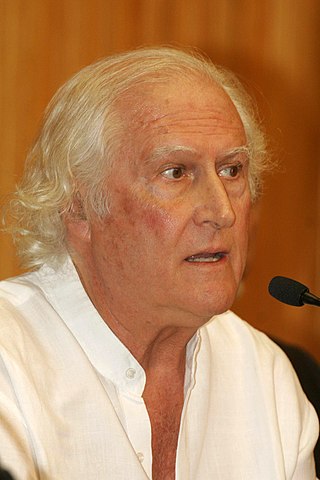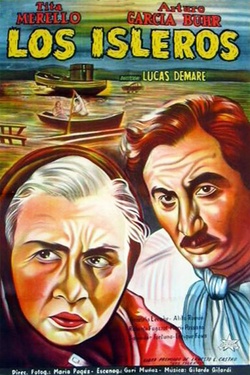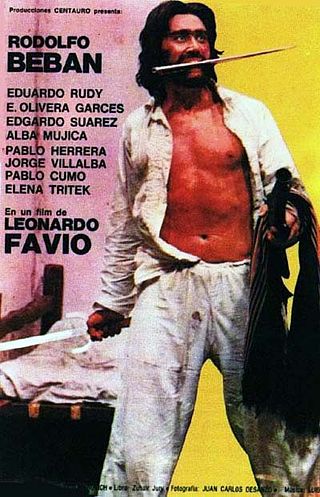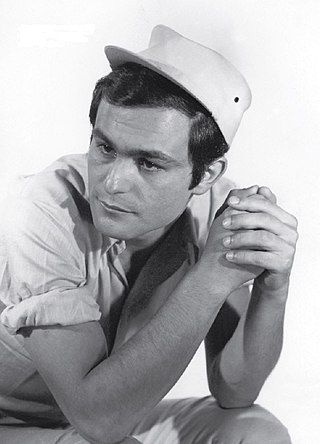Third Cinema is a Latin American film movement that started in the 1960s–70s which decries neocolonialism, the capitalist system, and the Hollywood model of cinema as mere entertainment to make money. The term was coined in the manifesto Hacia un tercer cine, written in the late 1960s by Argentine filmmakers Fernando Solanas and Octavio Getino, members of the Grupo Cine Liberación and published in 1969 in the journal Tricontinental by the OSPAAAL.

Fernando Ezequiel "Pino" Solanas was an Argentine film director, screenwriter, score composer and politician. His films include; La hora de los hornos (1968), Tangos: el exilio de Gardel (1985), Sur (1988), El viaje (1992), La nube (1998) and Memoria del saqueo (2004), among many others. He was National Senator representing the Autonomous City of Buenos Aires for six years, from 2013 to 2019.

Cinema of Argentina refers to the film industry based in Argentina. The Argentine cinema comprises the art of film and creative movies made within the nation of Argentina or by Argentine filmmakers abroad.
Santiago Álvarez Román was a Cuban filmmaker. He wrote and directed many documentaries about Cuban and American culture. His "nervous montage" technique of using "found materials," such as Hollywood movie clips, cartoons, and photographs, is considered a precursor to the modern video clip.

Dark River is a 1952 Argentine drama film directed by Hugo del Carril, starring del Carril, Adriana Benetti and Raúl del Valle. It is based on a novel by Alfredo Varela. The storyline is about exploitation of peons, and the film has a populist message that ties in with the director's sympathy for Peronism. The film won the Silver Condor Award for Best Film.

Hardly a Criminal is a 1949 Argentine crime drama directed by Hugo Fregonese. It was written by Raimundo Calcagno and Israel Chas de Cruz. The film started the director's Hollywood film directing career. It was re-released in theatres a few times during the 21st century.

La vuelta al nido is a 1938 Argentine psychological drama film written and directed by Leopoldo Torres Ríos and starring José Gola and Amelia Bence.

Kilómetro 111 is a 1938 Argentine musical film drama directed by Mario Soffici. The film premiered in Buenos Aires.

Los isleros is a 1951 Argentine film directed by Lucas Demare. It was entered into the 1951 Cannes Film Festival. It won the Silver Condor Award for Best Film.

Gatica, el mono is a 1993 Argentine drama film directed by Leonardo Favio. It is a biopic of Argentine boxer José María Gatica.
It won the Silver Condor for Best Film. It was selected as the Argentine entry for the Best Foreign Language Film at the 66th Academy Awards, but Leonardo Favio asked the Instituto Nacional de Cinematografía (INC) to remove it as a nominee in order to protest in delays of the Congress' approval of the Foreign Films taxes.
Octavio Getino was an Argentine film director and writer who is best known for co-founding, along with Fernando Solanas, the Grupo Cine Liberación and the school of Third Cinema.
The Grupo Cine Liberación was an Argentine film movement that took place during the end of the 1960s. It was founded by Fernando Solanas, Octavio Getino and Gerardo Vallejo. The idea of the group was to give rise to historical, testimonial and film-act cinema, to contribute to the debate and offer an open space for dialogue and freedom of expression that was illegal at that time. With strong anti-imperialist ideas, he harshly criticized Peronism and neocolonialism. In the subsequent years other films directors revolved around the active core of the Cine Liberación group.
Sur (South) is a 1988 Argentine drama film written and directed by Fernando E. Solanas. The film features Susú Pecoraro, Miguel Ángel Solá, Philippe Léotard, Lito Cruz, Ulises Dumont among others.

Juan Moreira is a 1973 Argentine dramatic historical film directed by Leonardo Favio and starring Rodolfo Bebán. It is based on the homonymous novel by Eduardo Gutiérrez, which narrates the life of the famous Argentine outlaw, gaucho and folk hero Juan Moreira.

Pajarito Gómez is a 1965 Argentine comedy film directed by Rodolfo Kuhn. It was entered into the 15th Berlin International Film Festival. It was also selected as the Argentine entry for the Best Foreign Language Film at the 38th Academy Awards, but was not accepted as a nominee. The film is a satire of the promotional machine behind the Argentine pop stars of the 1960s.

Tangos, the Exile of Gardel is an Argentine-French film released on 20 March 1986, directed by Fernando Solanas, starring Marie Laforêt, Miguel Ángel Solá and Philippe Leotard. The film was selected as the Argentine entry for the Best Foreign Language Film at the 59th Academy Awards, but was not accepted as a nominee.
Last Days of the Victim is a 1982 Argentine crime thriller film directed by Adolfo Aristarain and starring Federico Luppi. It was written by Aristarain and José Pablo Feinmann, and based on Feinmann's classic novel of the same name. The film was selected as the Argentine entry for the Best Foreign Language Film at the 55th Academy Awards, but was not accepted as a nominee.

His Best Student is a 1944 Argentine biographical drama film directed by Lucas Demare and starring Enrique Muiño and Ángel Magaña. It was released in Buenos Aires on 22 May 1944. The film won many awards, including the award for best film of the year.

Los martes, orquídeas is a 1941 Argentine black and white comedy film directed by Francisco Múgica and starring Mirtha Legrand, Enrique Serrano, Juan Carlos Thorry and Nuri Montsé. It won the Argentine Best Picture award for 1941. It was remade as the Hollywood classic You Were Never Lovelier (1942), starring Fred Astaire and Rita Hayworth.

The 100 Greatest Films of Argentine Cinema, also known as the Survey of Argentine cinema, are a series of opinion polls carried out to establish a list of the greatest films of Argentine cinema of all time. The original survey was carried out by the Museo del Cine Pablo Ducrós Hicken in the years 1977, 1984, 1991 and 2000. In 2022, a new edition was held, organized by the film magazines La vida útil, Taipei and La tierra quema, with support from INCAA, the Mar del Plata International Film Festival, the FestiFreak International Film Festival of La Plata, the Casa de la Cultura of General Roca and the Museo del Cine Pablo Ducrós Hicken.














